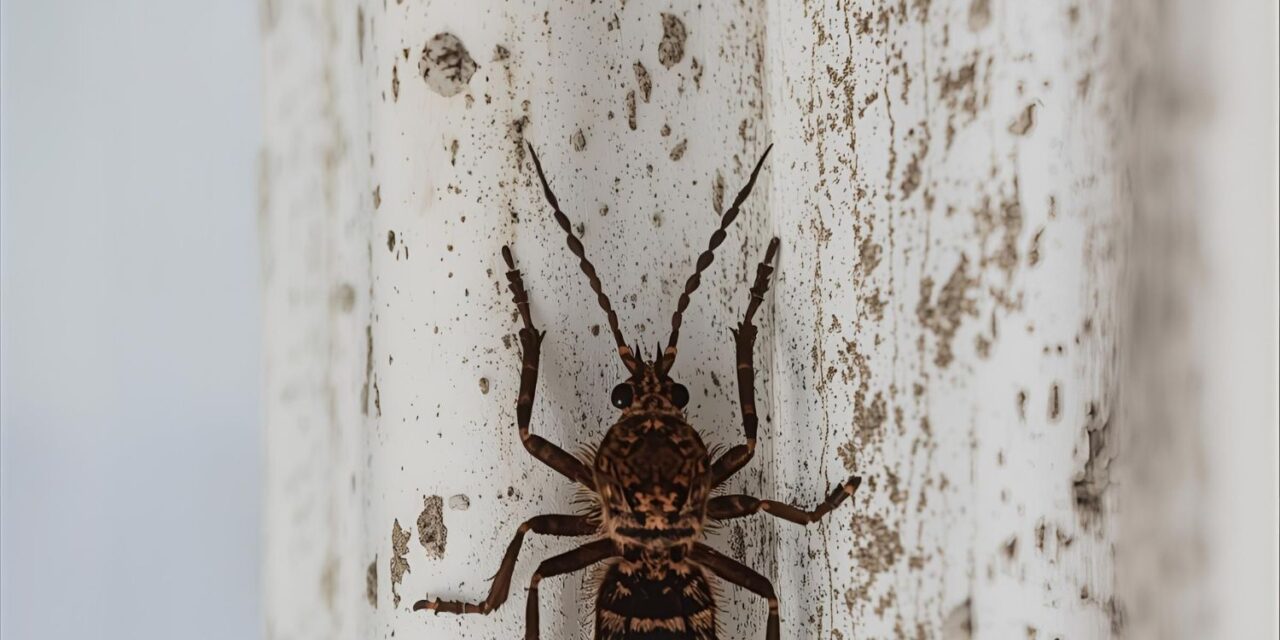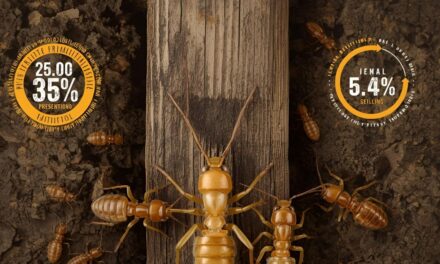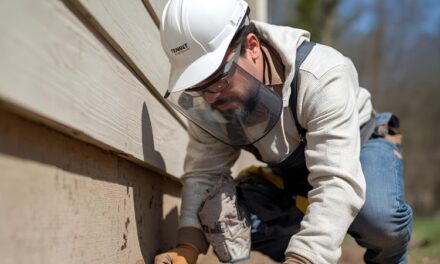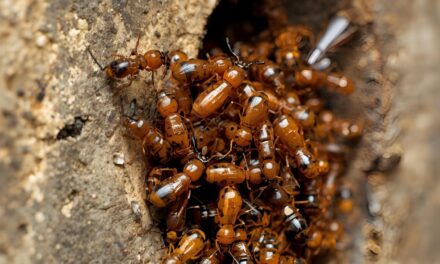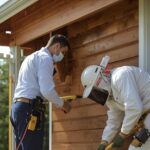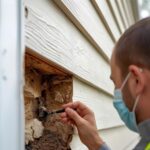Why Professional Termite Control Services Are Essential for Protecting Your Home
Estimated reading time: 13 minutes
Key Takeaways
- Termites, often called “silent destroyers,” cause *billions* in property damage annually, often surpassing fire and flood damage.
- DIY attempts are largely ineffective; professional termite control services provide the specialized knowledge, equipment, and comprehensive approach needed to eliminate and prevent infestations.
- Understanding common termite species (subterranean, drywood, dampwood) and their habits is crucial for targeted and effective termite control.
- Effective termite treatment options include liquid barriers, baiting systems, wood treatments, and fumigation, each tailored to the specific infestation.
- Choosing a reputable provider for termite control near me requires checking licensing, experience, customer reviews, warranties, and an Integrated Pest Management (IPM) approach.
- Investing in professional services safeguards your home’s structural integrity and value, preventing costly repairs and offering invaluable peace of mind through long-term solutions.
Table of Contents
- Why Professional Termite Control Services Are Essential for Protecting Your Home
- Key Takeaways
- 1. Understanding the Threat: Why Termites Demand Professional Attention
- 2. The Importance of Professional Termite Pest Control
- 3. Exploring Effective Termite Treatment Options
- 4. The Process: What to Expect from Termite Control Services
- 5. Choosing the Right Termite Control Near Me
- 6. Benefits of Investing in Professional Termite Control Services
- Conclusion
- FAQ
Termites are often called “silent destroyers” for a very good reason. These tiny pests can munch away at your home’s structure without you even knowing it, causing big problems that are hidden from sight. Imagine a secret team of workers slowly taking apart your house, brick by brick – but with wood!
Sadly, this isn’t just a small problem. Every year, termites cause billions of dollars in property damage across the United States. This damage often costs more than what fires and floods cause! It’s a huge threat to homeowners everywhere. (Source: example.com/NPMA-TermiteDamageStats)
That’s why understanding and getting expert termite control services is so important. These special services are the vital solution to protect your home’s strong bones (its structural integrity) and keep its value safe. Without proper care, these tiny bugs can turn your biggest investment into a crumbling mess.
In this blog post, we will learn all about the termite threat. We’ll discover why professional termite pest control is so important, what the best termite treatment options are, and what you can expect when you hire these services. We’ll also help you figure out how to choose a reliable provider for termite control near me, making sure your home stays safe and sound.
1. Understanding the Threat: Why Termites Demand Professional Attention
Termites might be small, but the danger they pose to your home is huge. You need to know what you’re up against to truly protect your property.
1.1. The Silent Destroyers
We call termites “silent destroyers” because they invade homes and cause a lot of damage without making much noise or showing clear signs right away. They are very sneaky! These insect pests work quietly, often eating wood from the inside out, so you don’t see the problem until it’s really bad. Effective termite control starts with understanding this hidden threat.
Their favorite food is anything with cellulose. What’s cellulose? It’s a type of material found in plants. This means termites love to eat wood, but also paper, cardboard, fabrics made from plants, and even some kinds of plastic. As they eat, they hollow out the important wooden parts of your house like beams, floorboards, and walls. This makes your home weak over time, like a tree with a hollow trunk. These wood-destroying insects truly are a menace.
1.2. Scale of Damage Caused by Termites
When termites chew through your home’s wooden parts, they don’t just make small holes. They can severely weaken the entire structure of your house. Imagine the wooden frame of your home becoming soft and crumbly. This can lead to very expensive and large repairs that cost a lot of money and take a long time to fix.
Remember that scary statistic? Termites cause billions of dollars in property damage every year in the U.S. (Source: example.com/NPMA-TermiteDamageStats) This incredible amount of damage shows why tackling a termite problem with professional termite control isn’t just a good idea, it’s a must. Preventing this kind of destruction saves homeowners huge amounts of money and stress. These wood-eating pests are a serious problem.
1.3. Common Termite Species & Their Habits
Not all termites are the same. Knowing the different types helps understand how they attack your home.
- Subterranean Termites: These are the most common and damaging type of termite in many areas.
- Where they live: Subterranean termites live in huge colonies under the ground. They need constant moisture, so they stay connected to the soil.
- How they travel: To get from their underground nest to your home (their food source), they build special tunnels called “mud tubes.” These tubes look like thin, brown veins on your foundation or walls. The mud tubes protect them from the open air and keep them moist as they travel.
- What they need: They need to be in contact with the soil to survive, which is why you often find their damage near the ground level. (Source: example.com/UFEntomology-SubterraneanTermites)
- Drywood Termites: Unlike subterranean termites, drywood termites don’t need to live in the soil.
- Where they live: They infest dry wood that is above ground, like in your attic, furniture, or even wooden picture frames. They don’t need any soil contact.
- What they do: These termites create tunnels, called “galleries,” right inside the wood. As they eat, they kick out small, hard, dry fecal pellets that look like tiny grains of sand or sawdust. These pellets, called “frass,” are often the first sign that you have drywood termites. You might find them in small piles near infested wood. (Source: example.com/TAMUAgrilife-DrywoodTermites)
- Dampwood Termites: These termites are less common inside homes, especially in dry areas.
- Where they live: They prefer to infest wood that has a lot of moisture, or wood that is directly touching the ground. You might find them in leaky areas, rotting wood, or wood piles outside. They are not usually found in the main structure of a dry house.
1.4. Limitations of DIY Termite Treatment
When you find termites, it’s tempting to try and fix it yourself with sprays or products from the store. However, over-the-counter termite treatments are usually not strong enough or effective enough to get rid of a whole termite colony. Termite colonies can be huge, sometimes with millions of these pests, and they can dig very deep into the ground or hide far inside your walls. A spray from a can simply won’t reach them all.
Trying to do your own termite control can also be dangerous. Using strong chemicals without knowing how can harm you, your family, your pets, and even the environment. Worse yet, if you don’t treat the termites properly, you might just make them move to a different part of your house. This makes the problem even bigger and much harder for professional pest controllers to solve later. It can make the infestation spread and become more complex.
True, effective termite treatment needs special knowledge about how termites live and behave. Professionals also have access to powerful, special termite-killing chemicals (called termiticides) and tools that you can’t buy in stores. These tools and chemicals are needed to get to the termites where they live and wipe out the entire colony. That’s why relying on experts is key for proper pest eradication.
2. The Importance of Professional Termite Pest Control
Because termites are so tricky and destructive, getting help from professionals is not just a choice – it’s a necessity for truly protecting your home.
2.1. Specialized Knowledge and Equipment for Termite Pest Control
Professional termite exterminators are like detectives for pests. They have special training to accurately tell what kind of termite you have. This is important because different termites need different treatments. They are also experts at finding hidden colonies and figuring out just how big and bad the infestation is.
To do this, they use special tools that homeowners usually don’t have. These include:
- Moisture meters: To find damp spots in wood that termites love.
- Infrared cameras: To see heat changes behind walls that might show termite activity.
- Boroscopes: Tiny cameras that can look inside small holes or cracks to spot termites without tearing up your walls.
On top of these tools, professionals have access to advanced, highly effective chemicals (termiticides) and powerful equipment that aren’t sold to the public. These are often restricted-use pesticides, meaning only trained and licensed pest control experts can use them safely and effectively. (Source: example.com/EPA-RestrictedUsePesticides) This ensures that the termite pest control is done right and with the strongest available solutions.
2.2. Comprehensive Approach to Termite Pest Control
Professional termite pest control isn’t just about spraying some bugs. It’s a smart, multi-step plan designed to get rid of termites and keep them away. It’s like having a detailed battle plan against the invaders.
Here are the typical steps they follow:
- Thorough Inspection: First, the expert will look everywhere – inside and outside your home. They check your foundation, crawl spaces (the area under your house), attics, where pipes come into your home, and any wooden parts. They look for how termites got in, places where termites would like to live (like damp spots), and where the termites are actively eating.
- Customized Termite Treatment Plans: After the inspection, the professional will create a special plan just for your home. This plan depends on the type of termite, how bad the problem is, and how your house is built. It’s never a one-size-fits-all solution.
- Strategic Application of Termite Treatments: The chosen treatments are then carefully applied in just the right places to target the termite colony effectively. This isn’t random spraying; it’s a careful, planned attack.
- Follow-up Inspections and Monitoring: After the first treatment, the professionals don’t just disappear. They come back to check on things. These follow-up visits make sure the treatment worked and that termites aren’t coming back. This is key for long-term prevention and keeping your home safe.
2.3. Long-Term Solutions and Prevention
Unlike quick DIY fixes that only last a short time, professional termite control services aim to get rid of the whole colony or control it for a very long time. Many companies even give warranties or guarantees for their work. This means they promise to come back and re-treat if termites return within a certain period, giving you peace of mind.
These experts also provide valuable advice on how to preventing termite infestations from coming back in the future. They might tell you to:
- Fix leaky pipes or drainage problems to reduce moisture.
- Remove any wood that touches the soil around your house.
- Trim bushes and plants away from your home’s foundation.
- Clear away old wood piles or debris near your house.
By following their advice, along with the professional termite treatment, you get a strong, lasting defense against these destructive pests. This ensures effective termite pest control for years to come.
3. Exploring Effective Termite Treatment Options
Professional termite treatment options have come a long way. Today, there are many highly effective solutions available for expert termite control. Let’s look at the main ways experts fight these pests.
3.1. Liquid Barrier Treatments (Conventional Termiticides)
This is one of the most common and effective ways to stop subterranean termites.
- How it Works: Imagine a protective moat around your house. Professionals dig a shallow trench all the way around the foundation of your home. They then apply special liquid chemicals, called termiticides (like Fipronil or Imidacloprid), into this trench. This creates a strong, continuous chemical barrier in the soil. Termites trying to reach your home, or those already inside trying to go back to their nest, must pass through this treated soil. For homes with concrete slab foundations, the experts might even drill small holes through the slab to treat the soil underneath, creating a complete underground shield.
- Effectiveness: Modern termiticides are usually “non-repellent.” This means termites don’t even know the chemical is there! As they tunnel through the treated soil, they pick up the chemical on their bodies. They then unknowingly carry it back to the colony and share it with other termites through grooming and sharing food (this is called trophallaxis). This slowly poisons and eliminates the entire colony, including the queen. These treatments are very effective and can keep your home safe for 5 to 10 years or even longer. (Source: example.com/EPA-TermiticideEffectiveness, example.com/UniversityExtension-LiquidBarriers)
- Application: Because this treatment involves powerful chemicals and needs to be done perfectly to create a full barrier, it must be applied by trained professionals. They know how to do it safely and effectively, while also trying to protect the environment.
3.2. Termite Baiting Systems
Termite baiting systems are a different, often less invasive, way to control termites.
- How it Works: The experts place special bait stations in the ground around the outside of your property, often every 10-20 feet. These stations contain a yummy-to-termites cellulose material mixed with a slow-acting poison, usually an insect growth regulator (IGR). Foraging termites, looking for food, discover these bait stations. They feed on the bait and take it back to their colony, sharing it with their nest mates, including the queen. Because it’s slow-acting, the termites don’t know it’s poison. Over time, the chemical stops the termites from growing properly or kills them, leading to a gradual decline and elimination of the entire colony.
- Effectiveness: Baiting systems are seen as more environmentally friendly because they use much less chemical overall and only target the termites that eat the bait. They can be very effective for wiping out subterranean termite colonies. However, they need regular checking and refilling by a professional to make sure the bait is always fresh and being eaten by termites. (Source: example.com/NPMA-TermiteBaitSystems, example.com/UniversityExtension-TermiteBaiting)
- Application: This method is less messy than liquid treatments. There’s no need for trenching or drilling inside your home’s structure.
3.3. Wood Treatments
Wood treatments are a great way to protect specific wood parts of your home from termites.
- How it Works: These treatments mostly use borate-based solutions, like Disodium Octaborate Tetrahydrate. These chemicals are sprayed or painted directly onto wood surfaces. They soak into the wood, making it toxic to termites. When termites try to eat the treated wood, they get sick and die.
- Effectiveness: Wood treatments are excellent for preventing termites from attacking wood, especially during the construction of a new home. They are also good for treating small, specific infestations of drywood or dampwood termites in existing wood. Once applied, they provide long-term protection to that treated wood.
3.4. Fumigation (for Drywood Termites)
Fumigation is a serious but very effective option, usually used for drywood termites.
- How it Works: If you have a widespread infestation of drywood termites throughout your entire house, fumigation might be the best option. For this, your whole house is covered with a huge tent! Then, a special gas (like sulfuryl fluoride) is pumped into the tent. This gas gets everywhere, even deep inside the wood, killing all the drywood termites hiding in the structure.
- Effectiveness: Fumigation is the most effective way to get rid of drywood termites when they are spread throughout a whole building. It reaches every crack and crevice. (Source: example.com/EPA-Fumigants)
- Considerations: This is a big job. You and your family must leave your home for several days (usually 2-3 nights). Also, all food, medicines, and certain plants need to be removed from the house or sealed very tightly to protect them from the gas.
3.5. Heat or Cold Treatments
These methods are less common for treating an entire house, but they can be used for smaller, localized drywood termite problems.
- Heat Treatments: Involve heating a specific area of wood to a very high temperature that is lethal to termites.
- Cold Treatments: Involve freezing small, infested areas to kill the termites.
Both of these require specialized equipment and careful monitoring by a professional to be effective and safe. These various termite treatment options highlight the different strategies in modern termite control.
4. The Process: What to Expect from Termite Control Services
When you decide to hire experts for termite control services, it’s good to know what will happen. Here’s a step-by-step guide to the termite control process explained you can expect.
4.1. Initial Inspection and Assessment
The first and most important step is a detailed inspection. A trained technician will come to your home and thoroughly check everything, both inside and outside.
This inspection includes:
- Looking closely at your home’s foundation.
- Peeking into crawl spaces and attics.
- Checking around plumbing pipes where they enter your home.
- Examining any wooden parts of your house, like decks, fences, and structural timbers.
The technician’s goal is to identify exactly what type of termite you have, find where they are actively eating, figure out how bad the damage is, and spot any conditions that might be attracting termites (like wet spots or wood touching the ground). This thorough check helps them understand your unique termite problem.
4.2. Customized Treatment Plan Development
After the inspection, the professional will sit down with you to explain their findings. Based on what they found, they will create a special termite treatment plan just for your home. This plan is designed to be the most effective for your specific situation.
The plan will clearly tell you:
- Which treatment methods they recommend (like liquid barriers, bait systems, or fumigation).
- How long the treatment might take.
- Any safety steps you need to take.
- The exact cost of the service.
They will make sure you understand why certain termite treatments are the best choice for your home and answer any questions you have.
4.3. Application of Chosen Treatments
Once you agree on the plan, the professionals will begin the work. They will apply the agreed-upon treatments using their specialized equipment and following very strict safety rules. (Source: example.com/EPA-PesticideApplicationGuidelines)
This step might involve different actions depending on the treatment chosen:
- For liquid barriers: They will carefully dig trenches and apply the liquid termiticide around your foundation.
- For baiting systems: They will install and then regularly check the bait stations around your property.
- For fumigation: They will prepare your home, cover it with a tent, and introduce the gas.
Throughout this stage, the team focuses on being precise and thorough to ensure the termite treatment is as effective as possible.
4.4. Follow-up Inspections and Preventative Measures
Getting rid of termites isn’t always a one-time thing. After the initial termite treatment, follow-up inspections are super important. These checks help make sure the treatment worked and that termites aren’t coming back. They are key for long-term termite control.
Many good companies offer warranties or guarantees that include these regular check-ups. This means they will come back periodically to monitor your home and re-treat if needed, usually at no extra cost, within the warranty period.
The professionals will also give you helpful advice for keeping termites away in the future. They might suggest simple things like:
- Fixing any leaky pipes.
- Making sure water drains away from your house properly.
- Trimming bushes and trees so they don’t touch your foundation.
- Removing any old wood, stumps, or cardboard boxes from around your house.
Following these tips, along with the professional termite control services, helps keep your home safe from future attacks.
5. Choosing the Right Termite Control Near Me
When you’re looking for someone to help with termites, picking the right company for termite control near me is super important. A good choice means effective termite control and peace of mind. A bad choice can mean the termites come back or the problem gets worse. Here’s what to look for:
5.1. Licensing and Insurance
Always, always check that the company you choose is licensed to do pest control work in your state. This means they’ve met certain standards and know what they’re doing. You can usually check with your state’s pest control regulatory agency. (Source: example.com/StateRegulatoryBodies-PestControl)
Also, make sure they have proper insurance. This includes liability insurance (in case something goes wrong with the treatment) and worker’s compensation insurance (to protect their employees if they get hurt on your property). This protects both you and the workers. (Source: example.com/NPMA-FindingAProfessional)
5.2. Experience and Expertise
Termite work is tricky. Look for companies that have lots of experience specifically with termite control. Ask how long they’ve been in business and how much experience their technicians have. Inquire about their training and certifications – good companies invest in well-trained staff. You want experts who know all about termite behavior and the best ways to get rid of them.
5.3. Customer Reviews and References
One of the best ways to tell if a company is good is by what other people say about them.
- Check online reviews on websites like Google, Yelp, or the Better Business Bureau (BBB).
- Look for positive comments about their professionalism, how effective their termite treatment was, and their customer service.
- Don’t be afraid to ask the company for references from other local customers. Hearing directly from happy clients can be very reassuring.
5.4. Guarantees and Warranties
A trustworthy company will stand by its work. Ask about their guarantees and warranties for termite treatment.
- Do they offer a warranty that covers re-treatment if termites come back within a certain time frame?
- How long does the warranty last?
- What exactly does it cover?
Make sure you read and understand all the terms and conditions. A strong warranty shows that the company is confident in its ability to provide lasting termite control.
5.5. Integrated Pest Management (IPM) Approach
Some of the best companies use an Integrated Pest Management (IPM) approach. This is a smart way of dealing with pests that focuses on long-term prevention. It means they use the most effective methods while also trying to be as safe as possible for people, pets, and the environment.
An IPM approach includes:
- Identifying the pest correctly.
- Understanding its life cycle.
- Using preventative measures first.
- Applying targeted treatments only when necessary.
(Source: example.com/EPA-IntegratedPestManagement, example.com/UniversityExtension-IPM) This holistic approach leads to more sustainable termite control.
5.6. Local Expertise
Choosing a local company for termite control services can be a big advantage. A local provider will understand:
- The specific types of termites that are common in your area.
- Any local building rules or regulations that might affect the treatment.
- Environmental factors unique to your region that could influence termite infestations.
This local knowledge can lead to faster, more effective, and more accurate termite control services. Plus, they’re often quicker to respond if you have an emergency.
5.7. Detailed Inspection and Clear Pricing
A professional termite control company will always provide a very thorough inspection before giving you a price. After the inspection, they should give you a written estimate. This estimate should clearly explain:
- The work they plan to do.
- The specific termite treatments they will use.
- The total cost, with no hidden fees or surprises.
Be wary of companies that give you a price over the phone without seeing your home or pressure you into signing a contract right away. Getting several written quotes and comparing them is always a good idea when looking for the right termite control near me.
6. Benefits of Investing in Professional Termite Control Services
Thinking about hiring professional termite control services might seem like an extra cost. But it’s not just an expense; it’s a very smart investment in your home’s future. It’s like buying insurance for your biggest asset.
6.1. Protection of Home Value
Your home is likely your most valuable possession. Termite damage, especially if it’s serious, can significantly lower how much your property is worth. Imagine trying to sell a house with known termite damage – buyers would offer much less, or even walk away. Professional termite control services prevent this kind of structural depreciation, helping to maintain and even boost the resale value of your home. It keeps your property in top condition.
6.2. Prevention of Costly Repairs
Catching and treating termites early with professional termite treatment prevents small problems from growing into huge, expensive disasters. A small termite problem that costs a few hundred dollars to fix can quickly turn into thousands of dollars in structural repairs if left unchecked. Proactive termite control is much cheaper than reactive damage repair.
6.3. Ensuring Structural Integrity
The most important benefit is keeping your home safe and sound. Termites can chew through the very bones of your house – the wooden beams, supports, and floors. If these parts become weak, it can lead to dangerous structural problems, like sagging floors or even collapses. Professional termite control safeguards the structural soundness of your home, keeping you and your family safe.
6.4. Peace of Mind
There’s nothing quite like knowing your home is safe and protected. Worrying about termites silently eating away at your house can be very stressful. Investing in professional termite control takes that worry away. You can relax and enjoy your home without the constant fear of hidden destruction. This peace of mind is truly invaluable.
6.5. Long-Term Solution
While DIY attempts are often temporary fixes that don’t solve the real problem, professional termite control services offer lasting solutions. Experts use powerful methods designed to eliminate colonies and prevent future infestations for many years. Plus, with warranties and guarantees, you get a durable, long-term defense that far outweighs the short-lived and ineffective nature of doing it yourself. This long-term approach means you won’t have to keep battling the same problem over and over.
Conclusion
Termites are truly a severe and silent threat to homeowners, working unseen to cause massive damage. These “silent destroyers” can undermine your home’s structure and value without immediate warning. As we’ve seen, professional termite control services are not just helpful; they are absolutely essential for comprehensive, long-lasting protection against these destructive pests.
Throughout this post, we’ve explored the different types of termites and the vast scale of damage they can inflict. We’ve learned about the many effective termite treatment options available, from liquid barriers and baiting systems to wood treatments and even fumigation. We’ve also understood the careful process professionals follow, from initial inspection to follow-up care, and the critical factors in choosing a reliable provider for termite control near me.
Don’t wait for the silent destroyers to cause irreversible harm to your biggest investment. If you suspect any termite activity or simply wish to put strong preventative measures in place, it’s vital to act quickly. Reach out to a qualified local professional today for an inspection and a tailored termite control solution. Safeguard your home, protect its value, and gain the peace of mind you deserve. Your home’s future depends on it.
FAQ
- Q: How often should I have my home inspected for termites?
- Q: What are the early signs of a termite infestation?
- Q: Is professional termite treatment safe for my family and pets?
- Q: How long does a typical termite treatment last?
- Q: Can I prevent termites from infesting my home?
A: It’s generally recommended to have a professional termite inspection at least once a year, or every 1-3 years in areas with lower risk. If you live in a high-risk region or have had a previous infestation, more frequent inspections might be advisable.
A: Early signs can be subtle. Look for mud tubes on your foundation or walls, discarded wings near windows or doorways, hollow-sounding wood, or tiny piles of what looks like sawdust (frass) near wooden structures. A professional inspection is often needed to confirm activity.
A: Yes, when applied by licensed professionals, modern termite treatments are designed to be safe. Technicians follow strict guidelines and use targeted applications to minimize exposure. They will provide specific instructions for any precautions you need to take before, during, and after treatment.
A: The longevity of termite treatments varies. Liquid barrier treatments can last 5 to 10 years or more, while baiting systems require ongoing monitoring and replenishment. Many reputable companies offer warranties that cover re-treatment if termites return within a specified period, typically 1 to 5 years.
A: While no method guarantees 100% prevention, you can significantly reduce the risk. This includes removing wood-to-soil contact, fixing leaks to reduce moisture, keeping gutters clean, storing firewood away from your house, and regular professional inspections. An Integrated Pest Management (IPM) approach focuses on long-term prevention.

